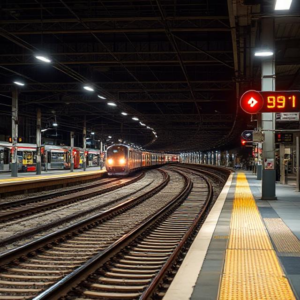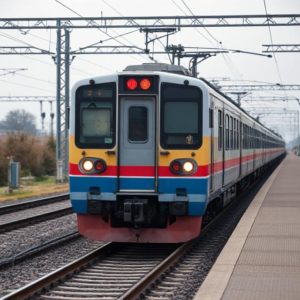What is 5G?
5G is the fifth generation of mobile network technology. It’s much faster and more powerful than 4G (the current network we use for mobile phones). It can handle much more data at higher speeds, with low latency (meaning less delay). This makes it perfect for systems that need real-time communication, like railways.
Now, let’s dive into how 5G can help improve railway communication.

Why 5G is Important for Railways
Railway systems are complex, involving a lot of equipment that needs to communicate with each other in real time. This includes things like:
- Trains talking to control centers.
- Trackside equipment talking to trains (for signals, warnings, etc.).
- Onboard systems (like brakes, doors, etc.) sending data to operators.
Currently, some systems use older technologies, and while they work, they can be slower or have limited bandwidth. 5G solves these problems by providing faster, more reliable, and more efficient communication.
Key Roles of 5G in Railway Communication
- Improved Real-Time CommunicationReal-time communication means information is sent and received instantly. In railways, this is super important. For example:
- If a train has to stop suddenly, the control center must know about it immediately.
- If there’s an emergency, the system needs to respond quickly.
5G makes this possible with its low latency (the time it takes for data to travel from one point to another). This means that information can travel faster, ensuring safer and smoother operations.
- Better Train Tracking and Monitoring5G allows continuous, high-speed data transmission. This is great for keeping track of trains. For example:
- The control center can track the exact location of every train at all times.
- Sensors on the train or tracks can send data about speed, condition, and location in real-time.
This helps operators adjust schedules, reroute trains if there are delays, and ensure safety.
- Enhanced Safety with Automated SystemsIn the future, trains may be more automated (controlled by computers instead of human drivers). 5G supports these systems because:
- It can handle large amounts of data from sensors that detect obstacles, speed limits, or signal changes.
- It allows systems like Automatic Train Protection (ATP) to work better by sending and receiving data quickly, ensuring automatic braking and collision avoidance if needed.
- Improved Communication Between Trains and Trackside EquipmentWith 5G, train-to-track communication becomes faster and more reliable:
- Trains can receive signal information (such as whether to stop or go) in real time, reducing the chance of errors.
- Trackside equipment (like signals, switches, and crossings) can send updates or alerts to the train instantly.
This makes the whole system more responsive and safe.
- Support for More Devices and SensorsTrains and the railway infrastructure are becoming more connected. There are more sensors (devices that collect data) on trains, tracks, and signals. These sensors measure things like:
- Train speed and location.
- Weather conditions that might affect track conditions.
- Health of train components (for maintenance).
5G has the capacity to handle lots of devices sending data at the same time, so the entire railway system can be smarter and more efficient.
- Better Passenger Experience5G also improves the passenger experience:
- Passengers can get real-time updates on train schedules, delays, and seat availability.
- It enables high-speed internet for passengers onboard, making travel more enjoyable.
- Smart stations: Stations can have intelligent systems that send real-time information to passengers about train arrivals, crowd management, etc.
- Advanced Video Surveillance and SecurityRailway systems use video surveillance for security purposes. With 5G, video data can be sent faster and clearer, improving the ability to monitor stations, tracks, and trains. This helps improve safety and prevent accidents or security breaches.
- Predictive Maintenance5G can help predict when a part of the train or track is likely to fail before it actually does. For example:
- Sensors on the train or track can monitor things like engine performance, brake health, or track wear.
- This data can be sent instantly to maintenance teams, who can then plan repairs before something breaks.
This is called predictive maintenance, and it reduces the chance of unexpected failures or accidents.
Summary: How 5G Improves Railway Communication
- Faster Communication: 5G speeds up communication between trains, control centers, and trackside equipment, which improves safety and efficiency.
- Real-Time Tracking: Trains can be continuously monitored, allowing for better coordination and timely responses to delays or emergencies.
- Enhanced Automation: With 5G, automated systems like train control and automatic braking can work more effectively.
- Better Passenger Service: 5G enables services like real-time updates, internet access, and smarter stations.
- Smarter Infrastructure: More sensors and devices can communicate faster and handle more data, making the system more reliable and efficient.
- Improved Security and Maintenance: Better video surveillance and predictive maintenance ensure a safer and more efficient railway system.
Conclusion
5G plays a critical role in modernizing railway communication. By providing faster, more reliable, and secure communication, it makes rail systems smarter, safer, and more efficient. Whether it’s for automating train operations, ensuring real-time communication, or improving the passenger experience, 5G is the key to making the railways of the future much better.
Keywords: Railway Communication, Railway











